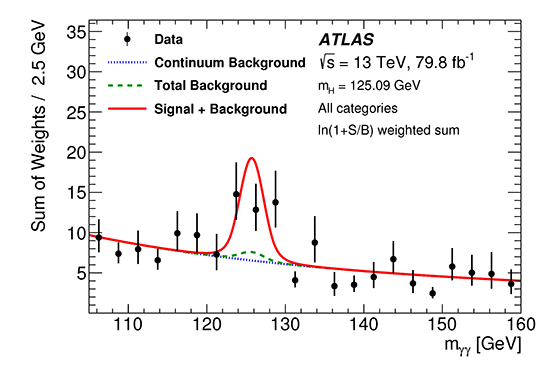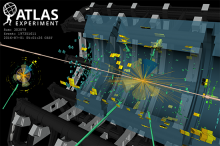Observation ttH, when the Higgs is accompanied by two top quarks
Following the discovery of the Higgs boson in 2012, a new major step has just been taken in understanding the mechanism that confers a mass to the elementary particles constituting matter. The ATLAS collaboration, which operates one of the giant detectors scanning the proton collisions produced by the CERN Large Hadron Collider (LHC) in Geneva, announced this morning at the LHCP conference in Bologna that it has observed the simultaneous production of the boson of Higgs and two top quarks, colloquially called “ttH production” by the experts.
“This is a fundamental measurement in the exploration of the Higgs mechanism,” commented Karl Jakobs, spokesperson for 3,000 physicists around the world forming the ATLAS collaboration. This result firmly establishes that the Higgs boson interacts directly with the quarks, which make up the protons and neutrons of matter. Moreover, the top quark being the most massive elementary particle, this measurement is a precise probe of the nature of this interaction.
“This research is one of the most difficult ever conducted in the experiment,” explains Fabio Cerutti, who coordinates all of the Higgs boson studies in ATLAS. In fact, this result, corroborated by CMS, the other great experience of the LHC, is a feat in more ways than one.

The result announced today is indeed the result of a staged analysis strategy carried out by many teams of the collaboration, exploiting the data collected between 2015 and 2017 at an energy of 13 TeV. At first, it is the disintegration of the Higgs boson in two quarks bottom that has been investigated. This is indeed the most likely disintegration, but it is very difficult to observe in the detector. With the accumulation of more data, it became possible to look for the decays of the Higgs boson including a pair of W bosons, a rarer mode but producing leptons, less ambiguous to identify in the detector. Finally, more recently, even rarer, but very clear experimental decay modes have also been combined. This is particularly the case of the disintegration of the Higgs boson in two photons which occurs once for 500 disintegrations. The combination of all these measures led to the observation of the ttH production with a statistical sensitivity of 6.3 standard deviations, thus beyond the threshold of 5 standard deviations traditionally required for a discovery. This threshold means that if the ttH production did not exist, the experiment had, at the most, about one chance out of 3.5 million to observe it by mistake.
LAPP’s ATLAS team played a major role in this study, exploiting its long-standing expertise in the two-photon decay channel, which led to the discovery of the Higgs boson in 2012. Since 2012, the measurement of couplings of the Higgs boson disintegrating into two photons, including the search for the ttH mode, is one of the main activities of the team. Two physicists from the team coordinated this activity in ATLAS for four years. LAPP’s group participated in the implementation of Higgs signal identification methods based on machine learning techniques, and had a essential role in the final statistical adjustment of the diphoton data, which highlighted the ttH production. Based on the local expertise for photon identification, related to the design and construction of part of the electromagnetic calorimeter by the laboratory, the team also played a leading role in improving the photon identification techniques, and to the extent of its effectiveness with the data. In the single diphoton channel, a statistical sensitivity of 4.1 standard deviations was obtained. A member of the group had editorial responsibility for the ATLAS collaboration of the combined publication just released, submitted this morning for publication in Physics Letters B.
References:
- ATLAS Collaboration, Observation of Higgs boson production in association with a top quark pair at the LHC with the ATLAS detector, arXiv:1806.00425, https://arxiv.org/abs/1806.00425
- https://atlas.web.cern.ch/Atlas/GRO…
Contact:
- Marco DELMASTRO, chercheur ATLAS au LAPP
Thumbnail picture:
- Visualization of a data event in the BDT ttH(γγ) hadronic region with the highest signal to background ratio. The photons correspond to the green lines of the electromagnetic calorimeter, while the jets and b-jets are represented respectively by yellow and blue cones.


